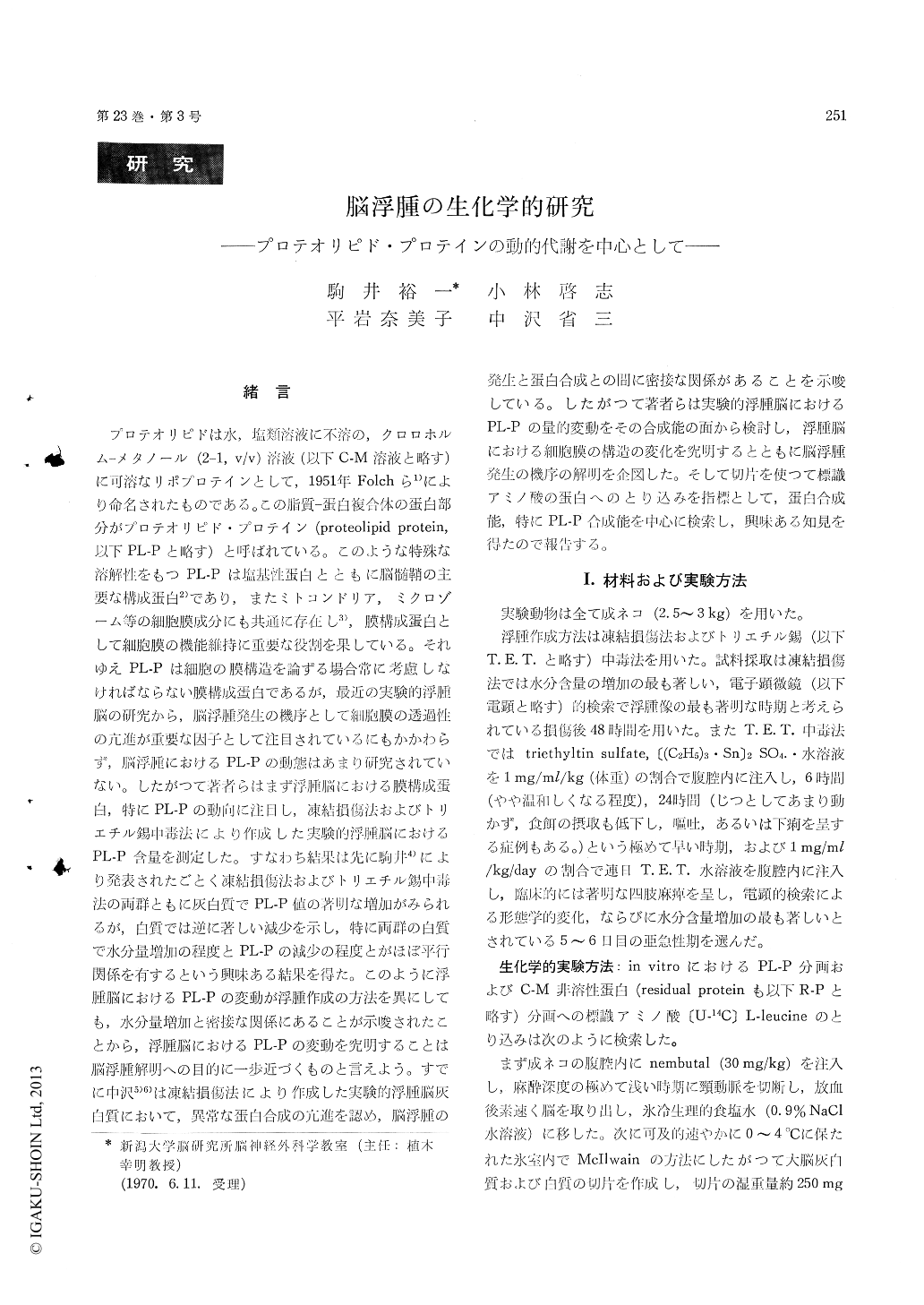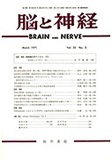Japanese
English
- 有料閲覧
- Abstract 文献概要
- 1ページ目 Look Inside
緒言
プロテオリピドは水,塩類溶液に不溶の,クロロホルム—メタノール(2-1,v/v)溶液(以下C-M溶液と略す)に可溶なリポプロテインとして,1951年Folchら1)により命名されたものである。この脂質—蛋白複合体の蛋白部分がプロテオリピド・プロテイン(proteolipid protein,以下PL-Pと略す)と呼ばれている。このような特殊な溶解性をもつPL-Pは塩基性蛋白とともに脳髄鞘の主要な構成蛋白2)であり,またミトコンドリア,ミクロゾーム等の細胞膜成分にも共通に存在し3),膜構成蛋白として細胞膜の機能維持に重要な役割を果している。それゆえPL-Pは細胞の膜構造を論ずる場合常に考慮しなければならない膜構成蛋白であるが,最近の実験的浮腫脳の研究から,脳浮腫発生の機序として細胞膜の透過性の充進が重要な因子として注目されているにもかかわらず,脳浮腫におけるPL-Pの動態はあまり研究されていない。したがつて著者らはまず浮腫脳における膜構成蛋白,特にPL-Pの動向に注目し,凍結損傷法およびトリエチル錫中毒法により作成した実験的浮腫脳におけるPL-P含量を測定した。すなわち結果は先に駒井4)により発表されたごとく凍結損傷法およびトリエチル錫中毒法の両群ともに灰白質でPL-P値の著明な増加がみられるが,白質では逆に著しい減少を示し,特に両群の白質で水分量増加の程度とPL-Pの減少の程度とがほぼ平行関係を有するという興味ある結果を得た。このように浮腫脳におけるPL-Pの変動が浮腫作成の方法を異にしても,水分量増加と密接な関係にあることが示唆されたことから,浮腫脳におけるPL-Pの変動を究明することは脳浮腫解明への目的に一歩近づくものと言えよう。すでに中沢5)6)は凍結損傷法により作成した実験的浮腫脳灰白質において,異常な蛋白合成の亢進を認め,脳浮腫の発生と蛋白合成との間に密接な関係があることを示唆している。したがつて著者らは実験的浮腫脳におけるPL-Pの量的変動をその合成能の面から検討し,浮腫脳における細胞膜の構造の変化を究明するとともに脳浮腫発生の機序の解明を企図した。そして切片を使つて標識アミノ酸の蛋白へのとり込みを指標として,蛋白合成能,特にPL-P合成能を中心に検索し,興味ある知見を得たので報告する。
The protein that is extracted from the tissue by chloroform-methanol (C-M, 2-1, v/v) mixture is generally designated as proteolipid protein. Proteolipid protein (PL-P) is most abundant in cerebral white matter but also occurs in a lesser concentration in cerebral gray matter and in some other tissues (Folch and Lees, 1951). There-after by many investigators PL-P is considered to be a main structural component of myelin sheath of the central nervous system. PL-P showed a marked increase in gray matter and a drastic decrease in white matter in experimental cerebral edema induced by cold injury and tri-ethyltin (T. E. T.) intoxication. Its decrease in edematous white matter was revealed to be rou-ghly proportional to the increase of water con-tent (Komai, 1969).
In the present experiment, we axttempted to study PL-P and residual, that is, C-M insoluble protein (R-P) syntheses in cold injured and T E. T. intoxicated cerebral edema, in order to elu-cidate the change of cellular membrane system, mainly the myelin sheath in cerebral edema and to find out the mechanism of the cerebral edema formation. All experimental animals used were adult cat of 2.5-3.0 kg. Slices of cat cerebral gray and white matter were incubated for 60 minutes in a medium containing 1 mM and 2μC (U-14>C) L-leucine. PL-P and R-P, isolated and purified by modified Mokrasch et al's method, were dried and weighed and its radioactivity was counted in a gas-flow counter. These examina-tions were carried out in 48 hours after produc-tion of cold injury as well as at 6 th and 24 th hour (acute stage) and on the fifth day after the intraperitoneal administration of T. E. T. sulfate of 1 mg/kg body weight per dose (subacute stage). It is already confirmed in our previous study and by many authors of cerebral edema that the prominent edematous changes occur at this stage of cold injury and at the subacute stage (fifth day) of T. E. T. intoxication. Normal cat brains without such treatment were used as a control group. The result is :
1. In normal brains, PL-P synthesis showed sensitivity as high as in R-P synthesis in gray matter. However, PL-P synthesis of white mat-ter showed remarkably lower activity than that of gray matter, and had relatively lower activity than in R-P synthesis of white matter. These results in vitro suggest that PL-P of myelin is metabolized very slowly compared with that of other cellular membrane system and that it is slower than other protein metabolism in white matter.
2. In cold injured edematous brains, PL-P and R-P syntheses both increased remarkably in gray and white matter.
3. In T. E. T. intoxicated edematous brains, PL-P and R-P syntheses of gray matter was both inhibited greatly at 6 th hour, being more severely inhibited on the fifth day, white matter both protein syntheses showed no change at 6thand 24 th hour but increased remarkably on the fifth day after T. E. T. sulfate administration.
These results confirm that both of PL-P and R-P showed enhanced metabolic activity in a prominently edematous white matter. In our previous experiment PL-P content of edematous white matter was shown to have decreased dras-tically while in the present study, PL-P synthesis is accelerated remarkably. This suggests that in edematous white matter PL-P breakdown pro-ceeds in advance of its synthesis. Therefore, it may be concluded that the drastic loss of PL-P content in edematous white matter is a chemical manifestation of the myelin destruction, which produced the rapid turnover of proteolipid pro-tein.

Copyright © 1971, Igaku-Shoin Ltd. All rights reserved.


